Moonstone Island is a game that is trying to be many things at once. On one hand, it’s a cozy life sim about setting up a farm, making yourself a little house, and maybe settling down with a friendly villager. On the other hand, it’s an expansive adventure game about monster collecting, uncovering dark secrets, and trying to survive against adversity.
It’s an interesting combination, and one that seems to come from Studio Supersoft seemingly throwing every influence they possibly could into Moonstone Island. On a surface level, it’s Rune Factory, where a simple farming life is combined with a series of seasonal-themed dungeons. There’s also a crafting system and inventory swiped out of Minecraft. Some of the house building aspects feel like they came out of recent Animal Crossing games, right down to the furniture shop having a similar layout. Combat is essentially every card battler out there, while your party consists of monsters you have pocketed like a certain popular Nintendo-exclusive franchise. All of this is wrapped up in a world that feels like a cross between Breath of the Wild and Wind Waker, but in the sky.
Bringing all these disparate elements together is ambitious. However, it’s also perhaps too much for a small indie team to manage, as most of my experience with Moonstone Island saw each these elements threaten to derail the others.
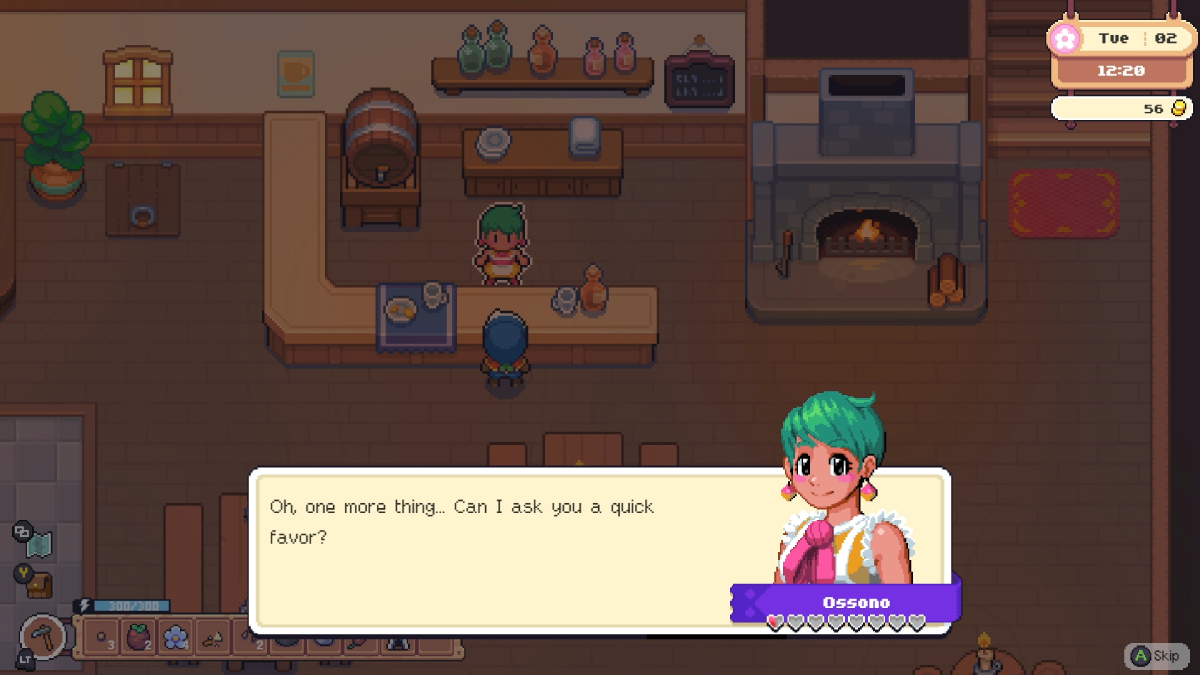
Let’s start with the good points. Straight out of the gate, Moonstone Island is a gorgeous little game, with absolutely beautiful pixel art everywhere you turn. Character portraits are incredibly expressive. Exploring through the sky sees subtle shifts in the environment through the time of day, weather changes, and effects of the island biomes. Even things like islands in the distance are a neat little touch that gives everything life. I cannot fault how this game looks.
The life sim aspects of Moonstone Island are also strong points. There’s a decently satisfying gameplay loop involving building a little farm, doing some crafting, and slowly assembling your dream home. There’s a charming vibe as you build up your little lair on the hill, assembling barns and greenhouses while doing all the things you expect from games in this genre.
Your fellow village residents are charming enough, usually found managing their little shops before heading off to the tavern every evening. The game is eager to get you interacting with them, as it throws options for flirting and inviting them out on dates from the moment you first bump into them. It’s a little aggressive, but at least it should leave players without a doubt on who you can date. (Spoilers: it’s everyone.)
Sadly, having recently played Rune Factory 3 Special, I couldn’t help but compare these townsfolk to those in Sharance. They don’t quite hold up. Like I said, they’re charming enough, but they do blur together a little. They also feel much more obviously mechanical. The options to chat, joke, and flirt don’t even spark conversations. They just make a number go up or down above their head. Dates with characters also feel extremely short and under-developed. After the instantly memorable and likable cast of Marvelous’ game, these NPCs felt comparatively hollow.
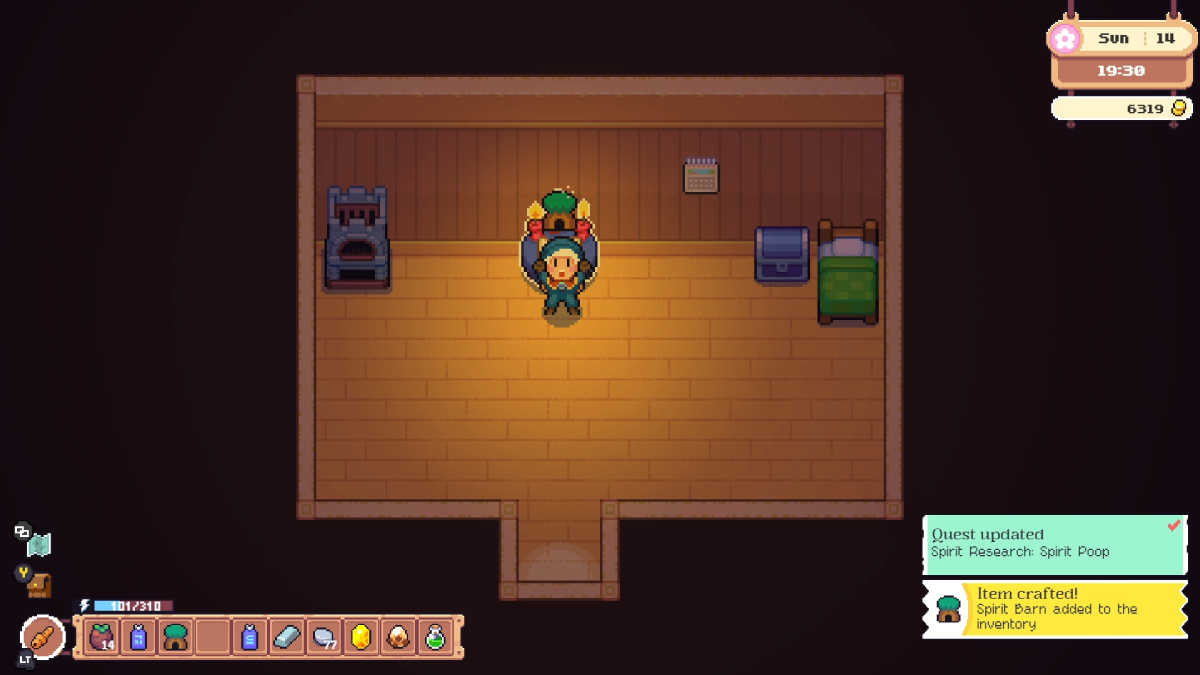
The limitations of the NPC writing are only the beginning of the cracks that show in Moonstone Island’s adorable veneer. While the life sim elements are enjoyable, there’s a persistent sense that everything the game offers has been done better elsewhere.
The inventory is so similar to Minecraft, but the limited crafting mechanics in comparison made me wish I was playing that instead. Upgrading your house feels a lot like Animal Crossing, but it’s simply a shop purchase and lacks the charm of Tom Nook being your benevolent and omniscient landlord. Bringing up Rune Factory again, the farming mechanics suffered from a lack of that game’s charged watering or random seed drops when harvesting crops.
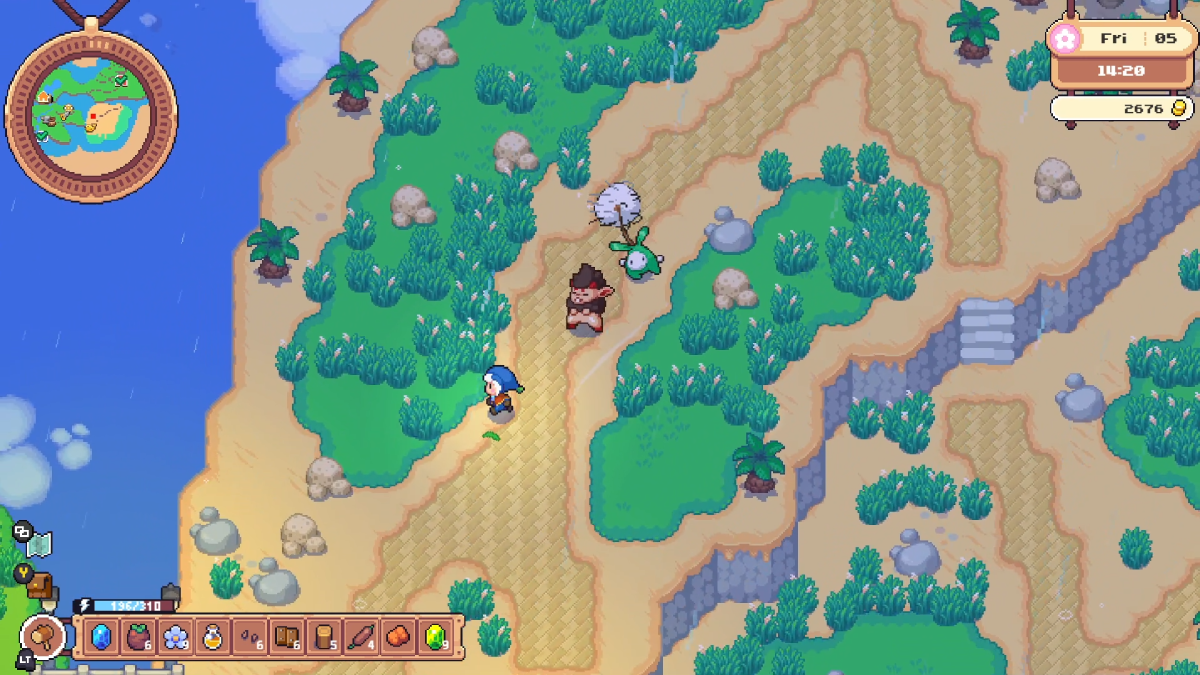
This is only half the game though. You are also tasked with exploring a series of sky islands littered with resources, enemies, and dungeons. Your initial exploration tool is a balloon that drifts excruciatingly slowly through the sky. Eventually this can be upgraded to a cute little broom and ultimately a glider that can keep you soaring through the sky for hours. Islands come in five flavors, with the gentle earth and water islands, poison islands that excrete gas clouds you must weave around, and the deadly electric and fire islands.
On each of these islands you’ll encounter hostile Spirits, with a types matching the island you find them on. It’s your job to battle these Spirits and tame them, throwing food at them until they agree to follow you. This is where the obvious Pokemon comparison comes in, as you gradually build up a squad of critters you can use to battle one another. There are some fun designs here. Dusty is kind of cheating, since it’s blatantly just a soot sprite from Spirited Away. But there’s also Fishbo, a fishbowl on legs, or Emoshroom, a poisonous redcap with a haircut from the mid-2000s, who are both very silly and therefore essential to have on your team.
However, once again this is where Moonstone Island fails to live up to its obvious influence. I encountered some early frustrations when I found myself unable to head out and do some monster collection, despite being encouraged to. You see, you can only carry three Spirits in your medallion, and you can’t store any more until you build a Spirit Barn. Building this requires a whole questline, a ludicrous amount of wood and stone, and some rare items that mean you’ll be a few hours into the game before you can really engage with one of its main selling points. Oh, and you’ll also need to build feed boxes for each slot in your Spirit Barn before you can catch more Spirits. In other words, you’ll be doing a lot of busywork simply to obtain an electric bee.
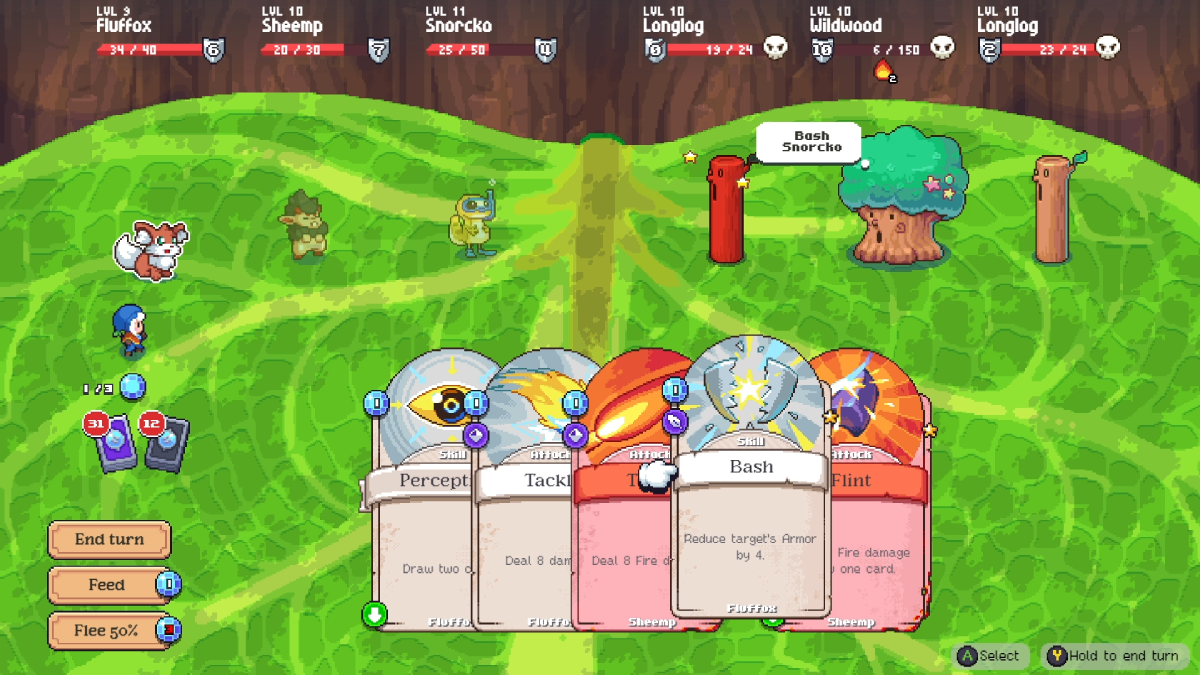
Battles are also a real chore. Moonstone Island opted to use a card-based battle system, where your attacks are based on a randomly drawn hand from decks assigned to your party. Spirits have a health bar and an armor count, and this armor must be broken down to do more damage. So it was endlessly frustrating when the game refused to give me cards that broke armor while fighting tanky enemies. I don’t just mean I was drawing poor hands. I also found myself earning fewer of these types of cards during each level up, which simply decreased the chances of seeing them show up in future hands.
Managing the decks of your critters is also painful. You can only make modifications to move sets using talismans obtained from magical arches across the islands. These are one time use and only reset once a season. You then feed these talismans to your Spirits to upgrade or remove cards, or add new ones to their collection. This must be done one talisman at a time. If you’d like a quick option to simply shuffle a deck around in a menu like other games, you’re not getting it here.
This leads to a lot of frustration as your decks fill up with less useful cards, modifying the decks is needlessly tedious, and you’re often left to the mercy of RNG in battles. I often found it more useful to reload when a battle went poorly than to try and salvage a string of bad hands. I found no challenge or satisfaction here, only frustration.
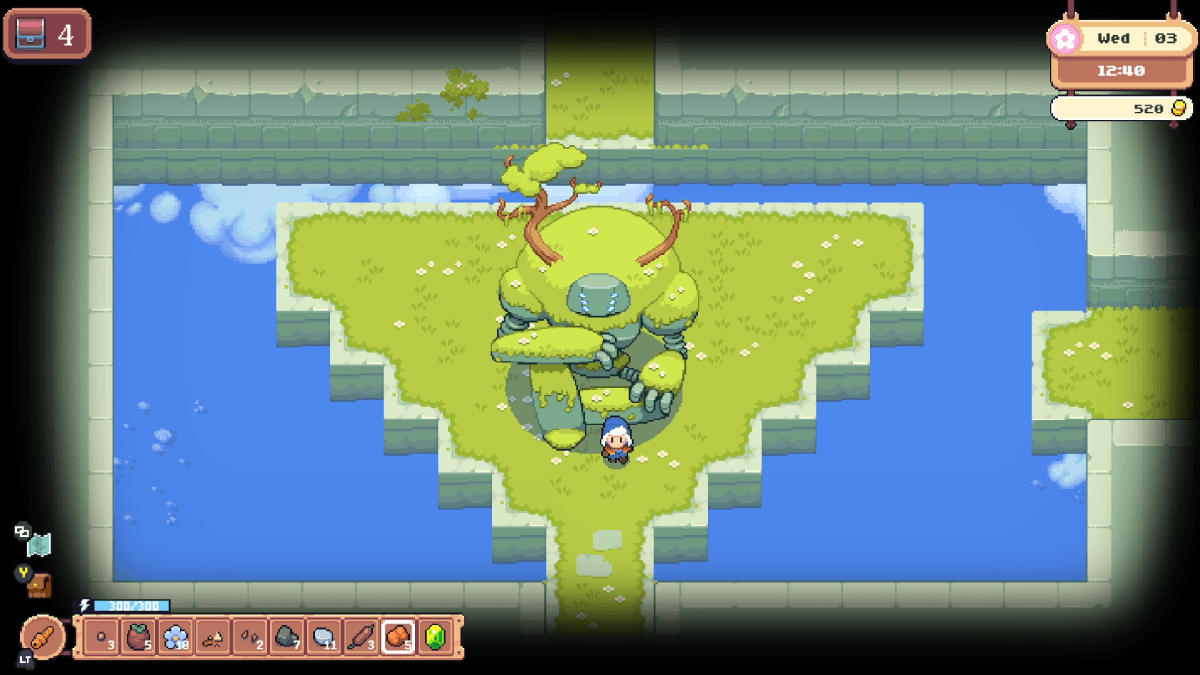
Moonstone Island tragically gets in its own way. This game was made by a team of just three people, so I want to root for it so badly. But perhaps the size of the team is even more reason for greater focus on one of its different elements. There could have been a really good life sim in here. There also could have been an interesting Pokemon competitor. It could have been a fun card battler. It could have been a great open world exploration game. But by trying to be all these things at once, each of these elements ends up feeling underdeveloped, and the combination often doesn’t work.
There’s clearly a lot of passion on display here, but I can’t help but feel there is a clash due to the enormity of their ambitions. The end result is a messy, occasionally frustrating and often tedious game that fails to live up to its many influences. Moonstone Island has the potential to be genuinely great, and it’s a genuine that it isn’t.
Moonstone Island is available now for PC. A Switch version is in development.
Moonstone Island is a creature-collecting life-sim set in an open world with 100 islands to explore. Make friends, brew potions, collect Spirits, and test your strength in card-based encounters to complete your Alchemy training! PC version reviewed.
Moonstone Island has the potential to be genuinely great, and it’s a genuine shame that it ends up feeling lesser than its many influences.
- There are three other Spirit types in the game, but they’re so rare and limited that it’s unlikely you’ll ever see them.
- The title theme has a similar melody to the verses of "No Surprises" by Radiohead, and I’m not sure that’s the right tone to be setting for a cozy farm game.
- The island exploration could have benefitted from a more obvious fast travel system, which I was unable to find during my playthrough.


Published: Sep 20, 2023 10:01 am